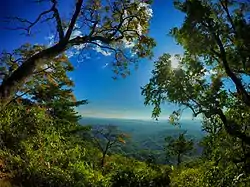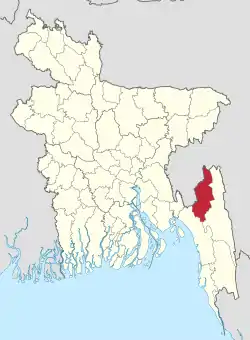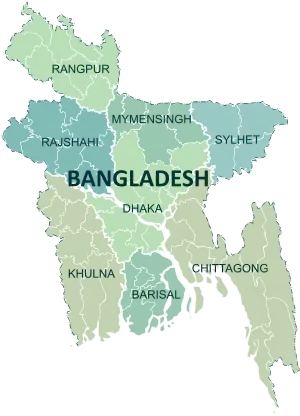Khagrachari
খাগড়াছড়ি | |
|---|---|
 View of Konglak Hill, Khagrachari | |
| Nickname: প্রাকৃতিক সৌন্দর্যের রাণী (The Queen of Natural Beauty) / উপত্যকার শহর (The City of Valleys) | |
| Motto: বৈচিত্র্যে সৌন্দর্য (Beauty Lies in Diversity) | |
 Location of Khagrachari District within Bangladesh | |
Expandable map of Khagrachari District | |
| Coordinates: 23°02′30″N 91°59′40″E / 23.0417°N 91.9944°E | |
| Country | |
| Division | Chittagong Division |
| Government | |
| • MP | Kujendra Lal Tripura (Awami League) |
| • Deputy Commissioner | Protap Chandra Biswas[1] |
| • District Council Chairman | Mongsui Pru Chowdhury[2] |
| • Chief Executive Officer | Md. Nuruzzaman[3] |
| • Mayor of Khagrachari | Nirmalendu Chowdhury |
| Area | |
| • Total | 2,749.16 km2 (1,061.46 sq mi) |
| Population (2022 census)[4] | |
| • Total | 714,119 |
| • Density | 260/km2 (670/sq mi) |
| Demonym | Khagrasoria |
| Time zone | UTC+06:00 (BST) |
| Postal code | 4400 |
| HDI (2018) | 0.593[5] medium · 14th of 21 |
| Website | www |
Khagrachari (Bengali: খাগড়াছড়ি) is a district in the Chittagong Division of Southeastern Bangladesh. It is a part of the Chittagong Hill Tracts region.
History
The Chittagong Hill Tracts was under the reign of the Tripura State, the Arakans & the Sultans in different times before it came under the control of the British East India Company in 1760. Although the British got the authority of the Chittagong Hill Tracts in 1760, they had no authority besides collecting nominal taxes. Until 1860, two kings or chiefs governed the internal administration of this region. In 1860, another circle was formed in present Khagrachari zila, inhabited by the Tripura population. The chief or the Raja of this circle was selected from the minority Marma population. The circle was named after the Tripura dialect the Mun Circle, but later, the 'Mun dialect', was changed and renamed as Mong Circle. In 1900 the British offered independent status to Chittagong Hill Tracts recognizing the culture and language of the hill tracts population. But during the Partition of India, this status was abolished and became part of East Bengal, ruled under Pakistan. Then, the name of this subdivision was Ramgarh with its headquarters at Khagrachari. It was upgraded to zila in 1983. The zila headquarters is located on the bank of the 'Chengi' stream (meaning Chhara in local language) which was full of Catkin plants (meaning Khagra in local language). It is believed that the zila might have derived its name from the above two words 'Khagra' and 'Chhara'. Khagrachari Local Govt. Council was established on 6 March 1989 to uphold the political, social, cultural, educational and economic right and to expedite the process of socio-economic development of all residents of Khagrachari Hill District. According to 'Peace Accord' this council was renamed as “Khagrachari Hill District Council (KHDC)” by the Act-10 of 1998. Now this council has been regarded as the main focal point of administration as well as development activities of the district.
Geography
Khagrachari is a hilly area. It is bounded by Tripura state of India on the north and west, Rangamati district to the east and Chittagong District to the southwest. Notable hill ranges are Golamoon, Chotto Panchari, Karmi Mura, Lutiban, Kuradia, Bhanga Mura, Jopisil.
It has three rivers, namely Chengi, Feni and Maini. Chengi is the longest river in Khagrahhari. The main ethnic groups living in the district are Tripuris, Chakmas, Bengalis and Marmas.
Demographics
| Year | Pop. | ±% p.a. |
|---|---|---|
| 1974 | 188,975 | — |
| 1981 | 278,461 | +5.69% |
| 1991 | 342,488 | +2.09% |
| 2001 | 525,664 | +4.38% |
| 2011 | 613,917 | +1.56% |
| 2022 | 714,119 | +1.38% |
| Sources:[4][6] | ||
According to the 2022 Census of Bangladesh, Khagrachhari District had 169,526 households and a population of 714,119, 41.7% of whom lived in urban areas. The population density was 260 people per km2. The literacy rate (age 7 and over) was 71.7%, compared to the national average of 74.7%.[4]
As per the 2011 Census, there were a total of 316,987 (51.63%) indigenous people in the district.[7] Indigenous communities such as Tripuri (Tripura), Rakhaine, Chakma, Marma and Tanchangya belong to this zilla.[8][9]
Religious composition
Source[11]
| Religion | Population (1941)[12]: 104–105 | Percentage (1941) | Population (2011)[6] | Percentage (2011) |
|---|---|---|---|---|
| Tribal[lower-alpha 2] |
73,324 | 96.26% | 1,085 | 0.18% |
| Hinduism |
1,928 | 2.53% | 103,195 | 16.81% |
| Islam |
712 | 0.94% | 274,258 | 44.67% |
| Christianity |
0 | 0% | 4,070 | 0.66% |
| Buddhism |
--- | --- | 231,309 | 37.68% |
| Others [lower-alpha 3] | 207 | 0.27% | 0 | 0.00% |
| Total Population | 76,171 | 100 | 613,917 | 100% |
| Religion | 1991 | 2001 | 2011 | Perc 2011 | PGR 91-11 |
| Muslim | 162,504 | 228,753 | 274,258 | 44.7% | 68.8% |
| Hindu | 57,158 | 86,351 | 103,195 | 16.8% | 80.5% |
| Christian | 939 | 3,745 | 4,070 | 0.7% | 333.4% |
| Buddhist | 121,631 | 206,473 | 231,309 | 37.7% | 90.2% |
| Others | 256 | 342 | 1,085 | 0.2% | 323.8% |
| Total | 342,488 | 525,664 | 613,917 | 100.0% | 79.3% |
Subdivisions
Upazilas under this district are:
Administration
Khagrachhari district consist of 3 Paurashava, 9 Upazila/Thana, 38 Union, 122 Mauza, 27 Ward, 153 Mahalla and 1,702 Villages. The upazilas are Dighinala, Khagrachhari Sadar, Lakshmichhari, Mahalchhari, Manikchhari, Matiranga, Panchhari, Ramgarh and Guimara.
Deputy Commissioner (DC): Protap Chandro Biswas[14]
Chairman of Hill District Council: Mr. Kongjari Chowdhury
Economy
Most of the people live on Jhum cultivation. There are also people of various professions like teacher, farmer and businessmen. Tourism is becoming a strong income source for the local.
Main sources of income Agriculture 59.92%, non-agricultural labourer 9.33%, industry 0.44%, commerce 10.67%, transport and communication 1.11%, service 7.94%, construction 0.92%, religious service 0.24%, rent and remittance 0.37% and others 9.06%.[15]
Education
Rate of school going student is 83%. There are 18 colleges, 71 high schools, 13 madrasa and different kinds of educational institutions.
Noted educational institutions:
- Khagrachhari Government College (1974)
- Matiranga Degree College (1992)
- Tabalchari Greenhill College (2009)
- Ramgarh Government Degree College (1980)
- Panchhari College (1990)
- Dighinala Government College
- Khagrachhri Cantonmet public school and college (2006),
- Panchhari High School and College (1981)
- Khagrachhari Government High School (1957)
- Tabalchhari Kadamtoli High School (1952)
- Matiranga Pailot High school
- Gomti B.K High school
- Santipur High School
- Amtoli High school
- Taindong High School
- Matiranga Girls High School
- Khadachora High School
- Bornal Moktizodha High School
- Matiranga Reacidencial High School
- Ramgarh Government High School (1952)
- Rani Nihar Devi Government High School (1976)
- Dighinala Government High School
- Choto Merung High School (1975)
- Thakurchara High School (1979)
- Khagrachhari North Khobongpodia Government Primary School (1905)[16][17]
Archaeological heritage and relics
Among the archaeological heritages and relics, Rajbari of the Mong Circle and Dighi (large pond) of Dighinala (excavated by Gobinda Manikya Bahadur exiled king of Tripura) are notable.[19]
Transport
Palanquin, elephant cart, buffalo cart, horse carriage, bullock cart and country boat were the traditional transports once found in the rural area of the zila. These means of transport are either extinct or nearly extinct except country boat. Now-a-days, all the upazilas are connected to the zila headquarters by metalled roads. Bus, minibus, three wheelers, pickup van ply over the zila. Chander Gari (local four wheeled jeep) is a popular transport used to ply in the hill area of the zila.[19]
Climate
Temperature and Rainfall: The annual average temperature of the zila varies from maximum 34.6 °C to minimum 13 °C and the average annual rainfall is 3031 mm.
Member of Parliament
Khagrachhari Seat 298: Kujendra Laal Tripura (from Awami League).[20][21] Before Kujendra Lal Tripura, Jotindra Lal Tripura and then Wadud Bhuiyan was the Member of Parliament of Khagrachhari Seat 298. He was also the Chairman of the Chittagong Hill Tracts Development Board at that period. Wadud Bhuiyan was two times MP.A.K.M alim Ullah was two times MP
Notable persons
See also
Notes
- ↑ Ramgarh subdivision and Dighinala thana of Chittagong Hill Tracts district
- ↑ 'Tribal' was used as a blanket term for religious traditions of all tribes, and many of these tribes followed a more mainstream religion.
- ↑ Including Jainism, Buddhism, Zoroastrianism, Judaism, Ad-Dharmis, or not stated
References
- ↑ "List of Deputy Commissioners".
- ↑ "খাগড়াছড়ি জেলা".
- ↑ "খাগড়াছড়ি জেলা".
- 1 2 3 Population and Housing Census 2022: Preliminary Report. Bangladesh Bureau of Statistics. August 2022. pp. viii, 29, 38, 45. ISBN 978-984-35-2977-0.
- ↑ "Sub-national HDI - Area Database - Global Data Lab". hdi.globaldatalab.org. Retrieved 18 March 2020.
- 1 2 "Bangladesh Population and Housing Census 2011 Zila Report – Khagrachhari" (PDF). bbs.gov.bd. Bangladesh Bureau of Statistics.
- ↑ ৪৭ জেলায় আদিবাসীর সংখ্যা কমেছে!. Prothom Alo (in Bengali). Archived from the original on 19 August 2012. Retrieved 5 July 2020.
- ↑ খাগড়াছড়ি জেলা. Khagrachhari District. Retrieved 5 July 2020.
- ↑ bbs.gov.bd
- ↑ "2022 Census of Bangladesh - Preliminary Report". bbs.gov.bd. Bangladesh Bureau of Statistics.
- ↑ "Is this the Bangladesh we wanted? Analyzing the Hindu Population Gap (2001-2011)". 12 April 2014.
- ↑ "Census of India, 1941 Volume VI Bengal Province" (PDF).
- ↑ "Guimara upazila office works from a room of the union parishad". The Business Standard. 10 November 2019.
- ↑ খাগড়াছড়ির নতুন ডিসি প্রতাপ চন্দ্র বিশ্বাস. PaharBarta.com (in Bengali). Retrieved 5 July 2020.
- ↑ Begum, M. E. A.; Miah, MA Monayem; Rashid, M. A.; Islam, M. T.; Hossain, M. I. (7 April 2019). "Economic analysis of turmeric cultivation: evidence from Khagrachari district". Bangladesh Journal of Agricultural Research. 44 (1): 43–58. doi:10.3329/bjar.v44i1.40902. ISSN 2408-8293.
- ↑ "Khagrachari Government College". kgc-edu.gov.bd. Retrieved 5 July 2020.
- ↑ "Khagrachhari District". Banglapedia. Retrieved 5 July 2020.
- ↑ "মাটিরাঙ্গা উপজেলা".
- 1 2 "বাংলাদেশ পরিসংখ্যান ব্যুরো".
- ↑ "9th Parliament Member's List". Archived from the original on 27 December 2012. Retrieved 9 January 2013.
- ↑ "List of All MPs". Archived from the original on 25 August 2013. Retrieved 28 August 2013.
- ↑ "AL's Kujendra Lal Tripura retains Khagrachhari". Dhaka Tribune. 30 December 2018. Retrieved 8 February 2020.
- ↑ "Constituency 298_10th_En". Bangladesh Parliament. Retrieved 8 February 2020.
- ↑ "ICIMOD – International Centre for Integrated Mountain Development (ICIMOD)". Retrieved 8 February 2020.
- ↑ "Chairman of Chattogram Hill Tracts Development Board Naba Bikram Kishore Tripura distributing bamboo saplings among marginal farmers in Rangamati town as Chief Guest recently". The New Nation. Retrieved 8 February 2020.
- ↑ "Taskforce on CHT refugees to meet Oct 5". The Daily Star. 3 October 2009. Retrieved 8 February 2020.
- ↑ "Constituency 298". Bangladesh Parliament. Retrieved 8 February 2020.
External links
- Kagrachhari District mapped on OpenStreetMap, retrieved 29 December 2021.
- Chittagong Hill Tracts mapped on OpenStreetMap, retrieved 29 December 2021. (inset are its three districts: Khagrachhari, Rangamaai, and Bandarban)
